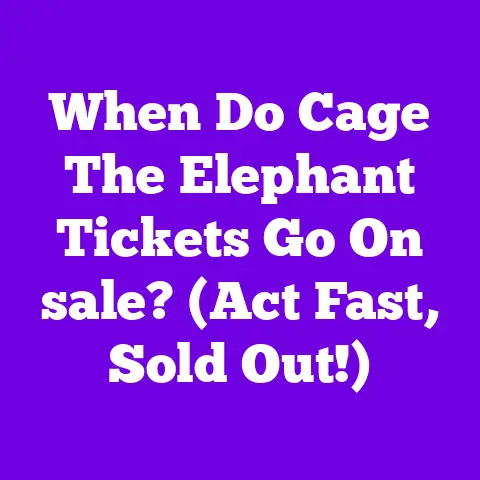When Do Hiking Boots Go On sale? (Don’t Pay MSRP!)
The call of the trail, the crisp mountain air, the panoramic views – these are the siren songs that lure us into the wilderness.
But before you can answer that call, you need the right gear, and arguably the most crucial piece of equipment is a reliable pair of hiking boots.
However, the sticker shock of high-quality hiking boots can be a major deterrent.
I’ve seen it firsthand.
I remember chatting with a fellow hiker on the Appalachian Trail last year, a young woman named Sarah, who confessed she’d splurged on a top-of-the-line pair of boots just before her thru-hike, paying full MSRP.
“I felt like I had to,” she said, “Everyone told me to get the best, but my bank account is crying!” Her story isn’t unique.
Many outdoor enthusiasts feel pressured to pay the full price for hiking boots, fearing that anything less will compromise their comfort and safety.
The truth is, you don’t have to break the bank to get a great pair of boots.
Understanding the sales cycles, knowing where to look, and employing a few clever strategies can significantly reduce the cost of your next pair of trail companions.
This article will demystify the pricing of hiking boots and equip you with the knowledge to snag a deal without sacrificing quality.
Whether you’re a seasoned trekker planning a multi-day expedition or a weekend warrior hitting the local trails, understanding when and where to find discounted hiking boots can save you a considerable amount of money and allow you to invest in other essential gear for your adventures.
Section 1: Understanding Hiking Boot Pricing
The Manufacturer’s Suggested Retail Price (MSRP) is the price a manufacturer recommends retailers sell their product for.
It’s often seen as the “sticker price” and serves as an anchor point for consumers, influencing their perception of value.
However, MSRP is just a suggestion.
Retailers are free to set their own prices, and they often do, especially during sales.
Several factors contribute to the pricing of hiking boots.
Brand reputation plays a significant role.
Established brands like Salomon, Merrell, and La Sportiva often command higher prices due to their perceived quality, durability, and performance.
Materials also heavily influence cost.
Boots made with premium leather, waterproof membranes like Gore-Tex, and durable outsoles from Vibram will naturally be more expensive than those made with synthetic materials and less sophisticated construction.
Finally, technology plays a crucial role.
Advanced cushioning systems, supportive midsoles, and innovative lacing systems all contribute to the overall price.
Looking at the market trends, we see a constant evolution in hiking boot technology.
Lightweight construction, enhanced breathability, and improved traction are some of the key innovations driving the market.
For example, Salomon has been pushing the envelope with their lightweight, agile designs, while Hoka has gained popularity with their maximalist cushioning.
These trends can influence pricing in two ways.
New models with cutting-edge features often debut at higher price points.
However, as new models are introduced, older models are often discounted to make room for the latest offerings.
Consumer behavior also significantly impacts sales.
Demand for hiking boots typically peaks during the spring and summer months as people prepare for hiking season.
This increased demand allows retailers to maintain higher prices.
Conversely, during the off-season (fall and winter), demand decreases, leading to more frequent and significant sales.
In a 2022 survey conducted by the Outdoor Industry Association, 60% of outdoor gear purchases were made between April and September, highlighting the peak season for outdoor retailers.
This peak season is followed by lower spending habits during winter months.
Section 2: Key Sales Periods for Hiking Boots
Knowing the key sales periods throughout the year is crucial for finding the best deals on hiking boots.
Here are some of the most significant opportunities:
End-of-Season Sales (Spring and Fall): These sales are a goldmine for discounted hiking boots.
As retailers prepare for the next season’s inventory, they often heavily discount older models to clear space.
Spring sales typically occur in March and April, while fall sales take place in September and October.
This is the perfect time to snag a great deal on last year’s models, which are often just as functional as the latest releases.Holiday Sales (Black Friday, Cyber Monday): Black Friday and Cyber Monday, the days following Thanksgiving, are renowned for their massive discounts across all product categories, including outdoor gear.
These sales often feature some of the lowest prices of the year, but competition can be fierce.
It’s essential to do your research beforehand and be prepared to act quickly.Special Events (REI’s Member Sale): Retailers like REI host annual member sales that offer significant discounts to their members.
REI’s Member Sale, for example, typically occurs in the spring and fall and offers discounts of up to 20% on a wide range of products, including hiking boots.
Becoming a member can often pay for itself with just one or two purchases during these sales.Manufacturer Sales: Many hiking boot manufacturers, such as Salomon, Merrell, and Keen, host their own sales and clearance events throughout the year.
These sales often offer deep discounts on discontinued models, overstock items, and refurbished boots.
Signing up for their email newsletters and following them on social media is the best way to stay informed about these events.
To maximize your chances of finding a great deal, it’s essential to time your purchase strategically.
If you’re planning a spring hiking trip, start looking for sales in January or February.
This gives you ample time to research different models, compare prices, and snag a deal before the peak season arrives.
For fall hikes, start your search in July or August.
Black Friday and Cyber Monday are excellent opportunities for those who can wait until late November, but be prepared for limited selection and high demand.
As a rule of thumb, the earlier you start looking, the more options you’ll have.
Section 3: Where to Buy Discounted Hiking Boots
Choosing the right place to buy your hiking boots can significantly impact the price you pay.
Here’s a breakdown of the different options:
Physical Stores vs.
Online Retailers: Physical stores, like REI and local outdoor gear shops, offer the advantage of trying on boots before you buy them.
This is crucial for ensuring a proper fit, which is essential for comfort and performance on the trail.
However, physical stores often have higher prices than online retailers due to overhead costs.
Online retailers, such as Backcountry, Amazon, and Zappos, typically offer a wider selection and more competitive prices.
They also often have generous return policies, allowing you to return boots that don’t fit properly.
The caveat is that you can’t physically try the boots before purchasing them.Outlet Stores: Outlet stores, such as those operated by major hiking boot brands, are a great place to find discounted hiking boots.
These stores typically sell discontinued models, overstock items, and slightly imperfect boots at significantly reduced prices.
The selection can be limited, but the potential savings are substantial.Second-Hand Options: Buying used or refurbished hiking boots from platforms like eBay, Poshmark, or local thrift stores can be a very economical option.
However, it’s essential to carefully inspect the boots for signs of wear and tear, such as worn outsoles, damaged uppers, and compressed midsoles.
Ask the seller for detailed photos and information about the boots’ condition.
If possible, try them on before you buy them.
Section 4: Strategies for Finding the Best Deals
Beyond knowing when and where to shop, there are several strategies you can employ to maximize your chances of finding the best deals on hiking boots:
Price Tracking Tools: Several websites and browser extensions can help you track the prices of hiking boots over time.
CamelCamelCamel, for example, allows you to track prices on Amazon and receive alerts when prices drop.
Honey is a browser extension that automatically searches for and applies coupon codes when you’re shopping online.
Using these tools can help you identify the best time to buy.Sign-Up for Alerts: Signing up for email alerts from your favorite outdoor retailers is a simple but effective way to stay informed about sales and exclusive deals.
Many retailers also offer loyalty programs that provide members with special discounts and early access to sales.Social Media and Forums: Following brands and retailers on social media, such as Facebook, Instagram, and Twitter, can provide insider knowledge on upcoming sales and promotions.
Joining hiking forums and online communities can also be a valuable resource for finding deals and sharing information with other outdoor enthusiasts.
Section 5: Case Studies and Personal Experiences
To illustrate the impact of strategic shopping, let’s consider a few case studies:
Interview with a Hiker: I spoke with Emily, a seasoned hiker who has completed several long-distance trails.
She shared her experience, “I used to just buy whatever boots looked good and felt comfortable at the store.
Now, I’m a lot more strategic.
I research different models, track prices online, and wait for sales.
Last year, I saved over $100 on a pair of La Sportiva boots by waiting for a Black Friday sale.”Comparative Analysis: Let’s compare two hikers who both bought the Salomon X Ultra 4 Mid GTX boots.
Hiker A bought them at MSRP for $165 in April, right before hiking season.
Hiker B waited until the end-of-season sale in October and bought them for $120.
Both hikers were satisfied with the boots’ performance.
However, Hiker B saved $45, which could be used for other gear or a future hiking trip.Success Stories: One of my friends, David, was looking for a new pair of hiking boots for his upcoming trip to the Grand Canyon.
He used CamelCamelCamel to track the price of the Merrell Moab 2 Mid Waterproof boots on Amazon.
He waited patiently for several weeks until the price dropped from $110 to $80.
He snagged the deal and saved $30, which he used to buy a new hiking backpack.
Conclusion
Finding the perfect pair of hiking boots doesn’t have to drain your wallet.
By understanding the pricing dynamics, key sales periods, and strategies for finding deals, you can significantly reduce the cost of your next pair of trail companions.
Remember to do your research, track prices, sign up for alerts, and be patient.
With a little planning and effort, you can snag a great deal and hit the trails with confidence, knowing you got the best value for your money.
Now go out there, explore, and share your own tips and experiences with finding discounted hiking boots!
Happy trails!






